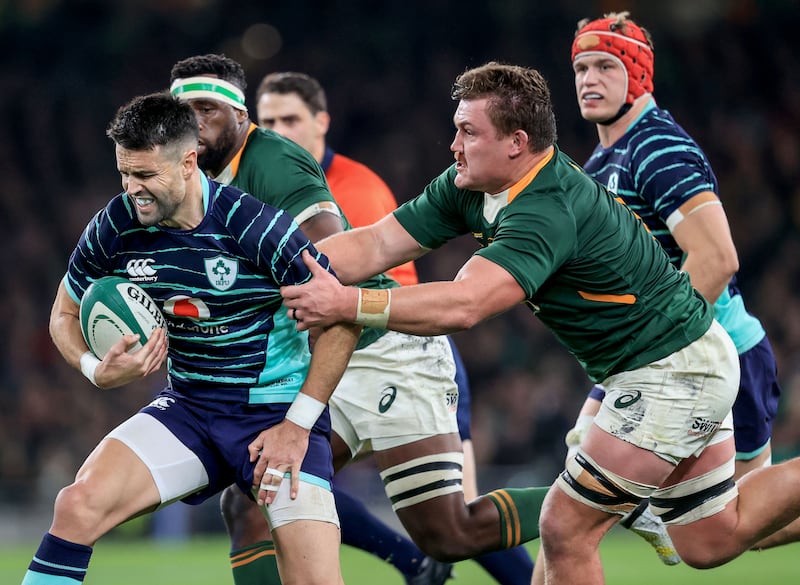The scrumhalf auditions began early Friday evening with the All Blacks and ended Saturday night with South Africa. Over two sleeps and Andy Farrell probably has no different an idea of the Irish hierarchy at nine as he had before the weekend began.
Jamison Gibson-Park, Conor Murray and Craig Casey had varying fortunes and outcomes. Questions were answered.
An Ireland A team going backwards for most of the match in the RDS brought the night of the All Black mauling to a weary close. Casey deserves another chance. With Conor Murray injured, it may come sooner than he thinks.
Murray will also have time to reflect on his 100th Irish outing that was turning in his favour when the non-contact injury at the end of the first half resulted in a limping exit. The irony is that executing the best offensive move of his 33 minutes on the pitch was the cause of the calamitous end.
READ MORE
The 33-year-old’s replacement arrived shortly before half-time. Jamison Gibson-Park, then gamely took advantage and after 45 minutes departed Aviva Stadium leaving few in doubt about the heartbeat of this Irish team. Its tempo and timing, its rhythm and enlightenment comes from Gibson-Park’s unfussy light touch and ability to give license to others to play.
The pity for Murray was that his forward burst was the first time in the game that he had been given a chink of light to show an offensive side of his game. From an attacking lineout a dummy pass out the Irish backline had the South African defence momentarily shifting balance.
Experience and the courage to run kicked in as Murray darted for the opening gap at the back of the lineout, making 20 yards of ground until his leg gave way and he was swallowed by Springbok shirts.
Until that point the Irish scrumhalf was involved in a robustly defensive game and as early as six minutes play was forced into a try-saving tackle on hooker Malcolm Marx. Cleverly breaking from a rolling maul and targeting the Irish halfback, Marx was taken down by Murray, who was never short on physicality.
For almost the entire first half, South African dominance forced Ireland into a game of short-phased play and box kicking. In the half hour up to Murray’s injury, Ireland had played no more than four consecutive recycles before the ball was either box-kicked or lost in contact.
On 14 minutes Springbok number eight Jasper Wiese was also able to step across and prevent Murray from clearing the ball from the breakdown resulting in a Springbok scrum.

But Murray showed real enterprise and at a South African scrum on 30 minutes, he ran the long way around the back and to the other side to sack the man that had earlier sacked him, Wiese.
Irish players were being hit receiving passes or just as they released such was the line speed of South African pressure, Jesse Kriel particularly adept at causing chaos. Subsequently Ireland’s continuity and accuracy suffered.
The four phases of play came on 31 minutes just before Murray heaved the ball high in the South African 22. This time hooker Dan Sheehan was applying pressure and blocked the clearing kick, gathered and raced for what looked like an Irish try before replays showed a knock forward prior to the touchdown.
Murray had a strong, aggressive first half and his physicality was vital to Ireland holding South Africa level going in at half-time. But Gibson-Park’s arrival was as breathless as it was a renovation to Ireland’s shape and ultimately the outcome.
His introduction on 36 minutes quickly gave agency to the outside players as he brought a different cadence to the play and the backline began to find momentum. Creating more space in a cluttered field as South Africa poured into contact, his measure, speed and tempo invited more Irish bodies into the game and bought them fractions of time.
Players began to take the ball and release it without feeling the air-pressure change of a charging Kriel or Damian De Allende bearing down.
The accent changed, the metre quickened and a purring Gibson-Park began to run the game. Hansen’s try on 50 minutes came from a piece of invention from the nine. Ireland turned over South Africa on the right and the ball arrived to Finlay Bealham who fed Gibson-Park. He knifed infield.
A top of the ground runner, he is no barreling Linford Christie but a light-footed Carl Lewis, his silent sweep inside barely making an imprint on the grass as Tadhg Beirne, Keenan and Jimmy O’Brien all brought the ball forward before Hansen finished.
There were a few Gibson Park box kicks that went straight in the air as Jacques Nienaber hauled Hendrinkse off to replace him with Faf de Clerk. But in the closing stages it was the scrumhalf beating out a short pick and drive game of management with the Irish forwards taking controlled contact and Ireland recycling the ball.
Farrell may not have learned more about his scrumhalves than he knew before it. But the weekend will have confirmed the effects of different strengths and styles, the pulse of Gibson Park playing out like a team metronome, Murray cut short but still able to show sides his game in a physically brutal match.
















